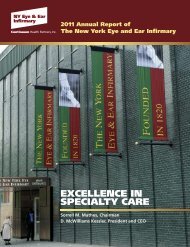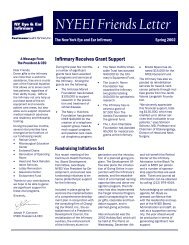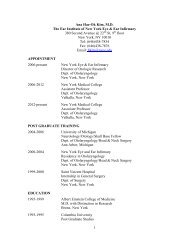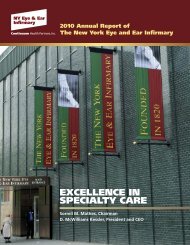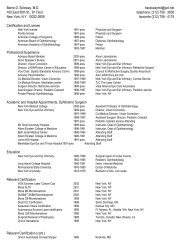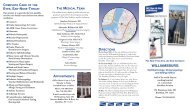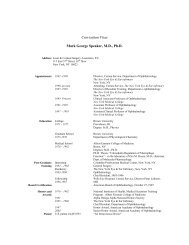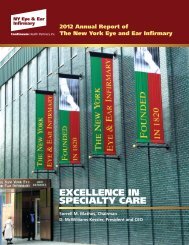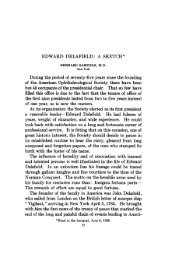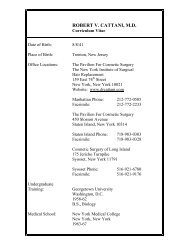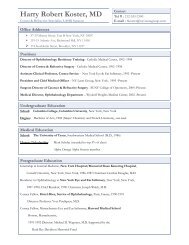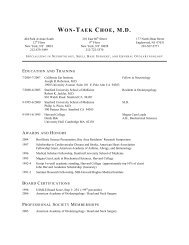okap review clinical trials in - New York Eye and Ear Infirmary
okap review clinical trials in - New York Eye and Ear Infirmary
okap review clinical trials in - New York Eye and Ear Infirmary
Create successful ePaper yourself
Turn your PDF publications into a flip-book with our unique Google optimized e-Paper software.
OKAP REVIEW<br />
CLINICAL TRIALS IN OPHTHALMOLOGY<br />
Ronald C. Gentile M.D.<br />
Co-Director Ocular Trauma Service<br />
Coord<strong>in</strong>ator Ret<strong>in</strong>a Service<br />
Assistant Professor of Ophthalmology<br />
The <strong>New</strong> <strong>York</strong> <strong>Eye</strong> <strong>and</strong> <strong>Ear</strong> <strong>Infirmary</strong><br />
3/20/01<br />
Outl<strong>in</strong>e<br />
Goal: To underst<strong>and</strong> the results <strong>and</strong> <strong>cl<strong>in</strong>ical</strong> implications of the some of the most<br />
important <strong>cl<strong>in</strong>ical</strong> <strong>trials</strong> <strong>in</strong> Ophthalmology<br />
1. DRS (Diabetic Ret<strong>in</strong>opathy Study)<br />
2. ETDRS (<strong>Ear</strong>ly Treatment Diabetic Ret<strong>in</strong>opathy Study)<br />
3. DVS (Diabetic Vitrectomy Study)<br />
4. DCCT (Diabetes Control <strong>and</strong> Complications Trial)<br />
5. MPS (Macular Photocoagulation Study)<br />
6. TAP (Treatment of ARMD with Photodynamic therapy)<br />
7. VIP 1 (Verteporf<strong>in</strong> <strong>in</strong> Photodynamic Therapy: Myopia<br />
8. VIP 2 Verteporf<strong>in</strong> <strong>in</strong> Photodynamic Therapy: ARMD Occult<br />
9. AREDS (Age-Related <strong>Eye</strong> Disease Study<br />
10. EVS (Endophthalmitis Vitrectomy Study)<br />
11. BVOS (Branch Ve<strong>in</strong> Occlusion Study)<br />
12. CVOS (Central Ve<strong>in</strong> Occlusion Study)<br />
13. CROP (Trial of Cryotherapy for ROP)<br />
14. SS (The Silicone Study)
1. DRS<br />
Began 1971<br />
Objective:<br />
1. Does photocoagulation reduce the risk of severe visual loss (< 5/200) <strong>in</strong><br />
diabetic ret<strong>in</strong>opathy.<br />
2. Establish natural history<br />
3. Compare effects of photocoagulation (Argon (blue-green) <strong>and</strong> Xenon arc) on<br />
regression PDR <strong>and</strong> its complications.<br />
Inclusion:<br />
1. PDR or severe NPDR (Extensive MA or RH, CWS, IRMA, V bead<strong>in</strong>g),<br />
2. Vac ≥ 20/100.<br />
3. TRD threaten<strong>in</strong>g the macula were excluded<br />
R<strong>and</strong>omization: One eye to laser<br />
Results:<br />
1. At 2 years, severe vision loss: 16% untreated versus 6% treated<br />
(5% Xenon arc, 7% Argon) At 4 years: 2x the 2 year result<br />
2. Regression of moderate <strong>and</strong> severe NVD 1 year after treatment <strong>in</strong> 62% treated<br />
38% untreated<br />
3. Risk factors for severe vision loss <strong>in</strong>cluded<br />
a. VH or preret<strong>in</strong>al H<br />
b. NV<br />
c. NVD<br />
d. Severe NV 1/3 DA NVD or 1/2 DA NVE<br />
2 years <strong>in</strong>cidence # of risk factors<br />
severe vision loss<br />
(untreated)<br />
4% 0<br />
7% 1<br />
9% 2<br />
27% 3<br />
37% All<br />
4. Initial loss of 2 to 4 l<strong>in</strong>es vision after laser 6 weeks 23% xenon arc, 10% argon,<br />
6% untreated at one year no difference. This was 2 times greater <strong>in</strong> eyes with<br />
preoperative macular edema.<br />
5. More field loss with Xenon arc <strong>and</strong> greater chance of 5 or more l<strong>in</strong>es of vision<br />
loss <strong>in</strong> eyes with fibrovascular proliferation secondary to extension of traction
2. ETDRS<br />
Began 1980<br />
Objective: Is photocoagulation surgery effective <strong>in</strong> non proliferative or early<br />
proliferative diabetic ret<strong>in</strong>opathy <strong>and</strong> what is the role of aspir<strong>in</strong> <strong>in</strong> reduc<strong>in</strong>g the<br />
risk of severe visual loss <strong>in</strong> diabetic ret<strong>in</strong>opathy.<br />
Inclusion / R<strong>and</strong>omization: 3 groups<br />
1. Mod to severe NPDR or early PDR without ME<br />
R<strong>and</strong>omized to full or mild scatter PRP or observation<br />
2. Mild or mod NPDR with ME<br />
R<strong>and</strong>omized to photocoagulation or deferral<br />
(4 treatment groups: immediate focal <strong>and</strong> deferral of full or mild scatter PRP until<br />
severe NPDR, or immediate full or mild scatter PRP <strong>and</strong> deferral of focal at least 4<br />
months <strong>and</strong> then done if CSME)<br />
3. Mod to severe NPDR or early PDR with ME<br />
R<strong>and</strong>omized to photocoagulation or deferral.<br />
(4 treatment groups: immediate mild or full scatter with or deferral of focal)<br />
* All patients were also r<strong>and</strong>omized to ASA 650 mg or placebo<br />
Results:<br />
1. <strong>Ear</strong>ly scatter PRP for NPDR or early PDR decreased the development of high<br />
risk PDR. Decreased 50% with full PRP, 25% with mild scatter PRP but did not<br />
significantly alter the end po<strong>in</strong>t of severe visual loss.<br />
2. Most effective treatment groups were focal before PRP<br />
3. Moderate vision loss (MVL) decreased by 50% at all time po<strong>in</strong>ts (Def<strong>in</strong>ition:<br />
Moderate vision loss equal to 15 letters, 3 l<strong>in</strong>es, a doubl<strong>in</strong>g of visual angle)<br />
All Treated<br />
MVL<br />
All not treated<br />
MVL<br />
CSME treated<br />
MVL<br />
CSME not treated<br />
% MVL<br />
1 year 5 % 8 % 1 % 8 %<br />
2 years 7 % 16 % 6 % 16 %<br />
3 years 12 % 24 % 13 % 33 %<br />
<strong>Eye</strong> with ME not CSME differences between treated <strong>and</strong> not treated did not reach<br />
statistical significance.<br />
4. ASA had no effect on progression of diabetes or occurrence of VH, cataract<br />
formation, or mortality
3. DVS<br />
Began 1982<br />
Objective: Natural coarse <strong>and</strong> effect of surgical <strong>in</strong>tervention on severe<br />
proliferative ret<strong>in</strong>opathy.<br />
Inclusion:<br />
Three major groups were studied.<br />
1. Group N (natural history).<br />
Coarse of Vac <strong>in</strong> severe PDR with conventional management.<br />
Consisted of 3 subgroups (a.) NN: severe NV, good Vac ≥ 10/50<br />
(b.) ND: TRD (4 disc areas) macula attached<br />
(c.) NH: VH Vac ≥ 10/200 or NHH Vac 5/200 to<br />
HM<br />
This was designed to determ<strong>in</strong>e which subgroup of eyes did poorly with<br />
conventional management <strong>and</strong> might benefit from early PPV. This was used to<br />
identify Group NR <strong>and</strong> Group H.<br />
2. Group NR (severe NV <strong>and</strong> good Vac)<br />
<strong>Ear</strong>ly PPV for severe PDR <strong>in</strong> eye with useful vision.<br />
3. Group H (VH Vac ≤ 5/200)<br />
<strong>Ear</strong>ly PPV for severe VH.<br />
R<strong>and</strong>omization:<br />
1. Group N was followed for 2 years<br />
2. Group NR <strong>and</strong> H were r<strong>and</strong>omized to early PPV or conventional management.<br />
3. The NR group was graded accord<strong>in</strong>g to severity of NV from NVC-1 (least<br />
severe) to NVC-4 (very severe)<br />
4. Conventional management group <strong>in</strong>cluded PPV if the follow<strong>in</strong>g developed:<br />
a.) TRD <strong>in</strong>volv<strong>in</strong>g the center of the macula<br />
b.) Severe VH Vac 5/200 or worse 1 year<br />
c.) Decrease VA from ≥ 20/50 to ≤ 10/100 by traction on posterior pole or<br />
fibrosis <strong>in</strong> front of the macula.<br />
d.) Rhegmatogenous RD<br />
5. PRP was performed at the discretion of the treat<strong>in</strong>g ophthalmologist<br />
Results:<br />
1. Group N<br />
Group NN<br />
50% got worse (≥ 2 l<strong>in</strong>es) at 1 year (Vac < 5/200 <strong>in</strong> 26%)<br />
Group ND<br />
40% no change Vac at 2 years, (Vac < 5/200: 15% at 1year, 23% at 2 years)
Group NH<br />
40% improved (≥ 2 l<strong>in</strong>es), 40% got worse, 20% same vision at 2 years.<br />
2. Group NR<br />
At 4 years, Vac ≥ 10/20: 44% early PPV versus 28% conventional (poor<br />
outcomes were similar)<br />
Prior PRP <strong>in</strong>creased the chances of good vision<br />
<strong>Ear</strong>ly PPV was advantageous as the severity of NV <strong>in</strong>creased.<br />
3. Group H<br />
At 2 years, Vac ≥ 10/20: 25% early PPV versus 15% conventional<br />
Significant Type I DM: 36% versus 12%<br />
Not for Type II DM: 16% versus 18%<br />
NLP was more common early PPV group compared to the conventional<br />
group through 18 mos. At 2 years this was not significant (25% versus 19%)<br />
Conventional Severe VH group: 22% cleared (Type I 16%, Type II 29%),<br />
11% developed TRD macula.
4. DCCT<br />
Began 1983<br />
Objective: To compare <strong>in</strong>tensive with conventional diabetes therapy for IDDM on<br />
the development <strong>and</strong> progression of vascular <strong>and</strong> neurological complications<br />
<strong>in</strong>clud<strong>in</strong>g diabetic ret<strong>in</strong>opathy.<br />
Inclusion:<br />
1. IDDM <strong>in</strong> good health without other medical conditions<br />
Two groups were <strong>in</strong>cluded:<br />
a.) Primary prevention group<br />
IDDM 1 – 5 yrs, no DR, Vac ≥ 20/25, & < 40 mg/day<br />
album<strong>in</strong>uria<br />
b.) Secondary prevention group<br />
IDDM 1 – 15 yrs, very mild to mod DR, Vac ≥ 20/32, & < 200<br />
mg/day album<strong>in</strong>uria<br />
R<strong>and</strong>omization:<br />
1. Conventional or <strong>in</strong>tensive <strong>in</strong>sul<strong>in</strong> therapy<br />
2. Conventional<br />
1 or 2 daily <strong>in</strong>jections<br />
3. Intensive<br />
3 or more daily <strong>in</strong>jections or external pump<br />
Adjustments <strong>in</strong> dose made us<strong>in</strong>g self-monitor<strong>in</strong>g<br />
Results:<br />
1. Intensive <strong>in</strong>sul<strong>in</strong> therapy versus conventional had:<br />
a.) Lower glycosylated hemoglob<strong>in</strong> A1c ( 7% versus 9%)<br />
b.) Lowered the onset of DR <strong>in</strong> the primary prevention group by<br />
approximately 50% at 5 years (9 yr. risk reduction 76% ) <strong>and</strong> lowered<br />
the progression of DR <strong>in</strong> the secondary prevention group by<br />
approximately 50% (9 yr. risk reduction 54%).<br />
c.) Approximately 50% decrease <strong>in</strong> development of severe NPDR, PDR,<br />
<strong>and</strong> need for photocoagulation.<br />
d.) To take at least 3 years to demonstrate a beneficial effect<br />
“Inherent momentum of the ret<strong>in</strong>opathy process”<br />
e.) <strong>Ear</strong>ly worsen<strong>in</strong>g of DR <strong>in</strong> the 1 st year of <strong>in</strong>tensive treatment<br />
f.) Decreased album<strong>in</strong>uria 54%, <strong>cl<strong>in</strong>ical</strong> neuropathy 60%, macrovascular<br />
disease 41%.<br />
g.) 2 to 3X <strong>in</strong>crease <strong>in</strong> severe hypoglycemia events <strong>and</strong> 33% <strong>in</strong>creased risk<br />
of becom<strong>in</strong>g overweight.
5. MPS<br />
Began 1980<br />
Objective: Does laser treatment to leak<strong>in</strong>g CNV membranes prevent significant<br />
loss of Vac compared to observation. Other issues concern persistence <strong>and</strong><br />
recurrences, wavelength of laser, <strong>and</strong> risk factors for the fellow eye.<br />
Inclusion:<br />
1. Extrafoveal CNV membranes<br />
(Posterior boundary between 200 <strong>and</strong> 2500 microns from center FAZ) <strong>and</strong><br />
Juxtafoveal CNV<br />
(Posterior edge between 1 <strong>and</strong> 199 microns from center FAZ) for<br />
3 disease entities<br />
a.) ARMD<br />
b.) POHS<br />
c.) IDIOPATHIC<br />
Subfoveal CNV membranes (under center of FAZ) for<br />
a.) ARMD only<br />
R<strong>and</strong>omization: To laser versus observation. Severe vision loss = 6 or more l<strong>in</strong>es<br />
Results:<br />
1. Laser decreased the risk of severe visual loss (SVL) <strong>in</strong> eyes with extrafoveal<br />
CNV secondary to AMD compared with no treatment<br />
A.)<br />
Follow up<br />
Extrafoveal<br />
ARMD Treated<br />
SVL<br />
18 months 25% 60%<br />
3 years 47% 62%<br />
5 years 46% 64%<br />
ARMD Observed<br />
SVL<br />
b.) After 5 yrs: observed eyes lost a mean of 7.1 l<strong>in</strong>es of Vac <strong>and</strong> lasered eyes lost<br />
5.2 l<strong>in</strong>es of Vac<br />
c.) Recurrences occurred <strong>in</strong> 54% of lasered eyes after 5 yrs (75% of which occurred<br />
with<strong>in</strong> the first year.<br />
d.) By 3 yrs the average Vac of lasered eyes with no recurrence was 20/50<br />
compared to those with a recurrence which was 20/250<br />
e.) Cigarette smok<strong>in</strong>g was associated with <strong>in</strong>creased risk for recurrence<br />
2. Laser decreased the risk of severe visual loss (SVL) <strong>in</strong> eyes with extrafoveal<br />
CNV secondary to POHS <strong>and</strong> IDIOPATHIC CNV compared to observation.<br />
Follow up<br />
POHS<br />
SVL<br />
IDIOPATHIC<br />
SVL
Extrafoveal Treated Observed Treated Observed<br />
18 months 9% 34% * *<br />
3 years 10% 45% 20% 36%<br />
5 years 12% 42% 23% 48%<br />
3. Laser decreased the risk of severe visual loss (SVL) <strong>in</strong> eyes with juxtafoveal<br />
CNV secondary to AMD compared with no treatment<br />
A.)<br />
Follow up<br />
Juxtafoveal<br />
ARMD Treated<br />
SVL<br />
1 year 31% 45%<br />
3 years 50% 61%<br />
5 years 54% 65%<br />
ARMD Observed<br />
SVL<br />
b.) After 5 yrs: observed eyes lost a mean of 6.2 l<strong>in</strong>es of Vac <strong>and</strong> lasered eyes lost<br />
5.0 l<strong>in</strong>es of Vac<br />
c.) Persistence/Recurrence<br />
Def<strong>in</strong>itions:<br />
Persistence - presence of fluoresce<strong>in</strong> leakage on the periphery of the foveal<br />
side of the laser scar with<strong>in</strong> 6 weeks follow<strong>in</strong>g laser.<br />
Recurrence - leakage 6 weeks subsequent to laser<br />
Recurrences occurred <strong>in</strong> 47% of lasered eyes after 5 years <strong>and</strong> persistence<br />
occurred <strong>in</strong> 32% of lasered eyes.<br />
Persistent <strong>and</strong> recurrent CNV were associated with poor visual outcome<br />
d.) By 3 yrs the average Vac of lasered eyes were 20/200 compared to 20/250 of<br />
the observed eyes.<br />
e.) Benefit was greatest for patients without HTN. Patients with def<strong>in</strong>ite HTN,<br />
there was no benefit of laser.<br />
4. Laser decreased the risk of severe visual loss (SVL) <strong>in</strong> eyes with juxtafoveal<br />
CNV secondary to POHS, <strong>and</strong> IDIOPATHIC CNV compared to observation.<br />
Follow up<br />
POHS<br />
SVL<br />
IDIOPATHIC<br />
SVL<br />
Juxtafoveal Treated Observed Treated Observed<br />
3 years 5% 25% 10% 37%<br />
5 years 12% 28% 21% 34%
5. Treatment of subfoveal CNV <strong>in</strong> ARMD. Two <strong>trials</strong><br />
a.) Subfoveal CNV <strong>in</strong> eyes with no previous photocoagulation.<br />
(<strong>New</strong> Subfoveal CNV Study)<br />
b.) Subfoveal CNV that developed after laser for extrafoveal or juxtafoveal<br />
CNV.<br />
(Subfoveal Recurrence CNV Study)<br />
c.) Eligibility criteria <strong>in</strong>cluded FA evidence of well-demarcated CNV lesion.<br />
<strong>New</strong> Subfoveal Study: Boundaries no greater than 3.5 disc areas<br />
Subfoveal Recurrent CNV Study: Boundaries no greater than 6 disc areas<br />
(previous lasered area plus planned laser area). Area 1.5 mm from FAZ<br />
untreated.<br />
d.) Laser treatment of subfoveal CNV (new or recurrent) <strong>in</strong> ARMD resulted <strong>in</strong> an<br />
<strong>in</strong>itial drop <strong>in</strong> visual acuity but after 1 year resulted <strong>in</strong> a decrease <strong>in</strong> SVL <strong>in</strong><br />
lasered eyes compared to observed eyes<br />
Follow up<br />
<strong>New</strong> Subfoveal<br />
SVL<br />
Recurrent Subfoveal<br />
SVL<br />
Treated Observed Treated Observed<br />
3 months 20% 11% 14% 9%<br />
2 years 20% 37% 9% 28%<br />
3 years 17% 39%<br />
4years 23% 45%<br />
e.) In the <strong>New</strong> Subfoveal CNV, persistent or recurrent CNV was noted <strong>in</strong> 51% of<br />
lasered eyes by 24 months, but unlike other MPS <strong>trials</strong>, this was not associated<br />
with a worse VA outcome.<br />
f.) <strong>New</strong> Subfoveal CNV eyes were subgrouped accord<strong>in</strong>g to Vac <strong>and</strong> size of CNV<br />
membrane. Group A to Group D ranged from small membrane with poor vision<br />
(Group A) to large membrane with good vision (Group D). Group A faired the<br />
best with lasered eyes better throughout follow-up <strong>and</strong> Group D faired the worst<br />
with lasered eyes substantially worse for the first 18 months <strong>and</strong> little difference<br />
thereafter. Groups B <strong>and</strong> C results were between A <strong>and</strong> D.<br />
e.) Argon green <strong>and</strong> krypton red wavelengths were comparable with respect to<br />
visual outcomes <strong>and</strong> complications.
6.) Independent risk factors for CNV <strong>in</strong> fellow eyes<br />
a.) Fellow eyes of extrafoveal ARMD CNV:<br />
i. Focal hyperpigmentation<br />
ii. Large drusen (> 50 microns)<br />
5-year <strong>in</strong>cidence CNV, 10% without versus 58% with both risk factors.<br />
b.) Fellow eyes of juxtafoveal <strong>and</strong> subfoveal ARMD CNV<br />
i. ≥ 5 drusen<br />
ii. Focal hyperpigmentation<br />
iii. ≥ 1 large drusen (> 63 microns)<br />
iv. Systemic hypertension<br />
5-year <strong>in</strong>cidence CNV, 7% without versus 87% with all 4 risk factors.
Began 1998<br />
Objective: To determ<strong>in</strong>e if photodynamic therapy with verteporf<strong>in</strong> (Visudyne;<br />
CIBA Vision Corp) can safely reduce the risk of vision loss <strong>in</strong> patients with<br />
subfoveal choroidal neovascularization caused by age-related macular<br />
degeneration (AMD).<br />
Inclusion:<br />
1. Subfoveal CNV lesions caused by AMD<br />
2. Measur<strong>in</strong>g ≤ 5400 microns (greatest l<strong>in</strong>ear dimension)<br />
3. Evidence of classic CNV<br />
4. Best-corrected visual acuity of approximately 20/40 to 20/200.<br />
R<strong>and</strong>omization:<br />
1. Verteporf<strong>in</strong> (6 mg/m2) or placebo (<strong>in</strong>travenous <strong>in</strong>fusion of 30 ml over 10<br />
m<strong>in</strong>ute.<br />
2. Laser light at 689 nm (50J/cm2) (600 mW/cm2) 83 seconds us<strong>in</strong>g a spot size<br />
1000 microns larger than the greatest l<strong>in</strong>ear dimension of the CNV.<br />
3. Follow-up exam<strong>in</strong>ations Q 3 months, retreatment if angiography showed<br />
fluoresce<strong>in</strong> leakage.<br />
Primary outcome<br />
1. Proportion of eyes < 15 letters lost (
7. VIP 1<br />
Began 1998<br />
Objective: To determ<strong>in</strong>e if photodynamic therapy with verteporf<strong>in</strong> (Visudyne;<br />
CIBA Vision Corp) can improve the chance of stabiliz<strong>in</strong>g or improv<strong>in</strong>g vision ( 90% of each group had classic CNV (regardless of whether occult<br />
CMV was present) <strong>and</strong> only 12 (15%) verteporf<strong>in</strong> group <strong>and</strong> 5 (13%) placebo<br />
group had occult CNV.<br />
2. Vac, contrast sensitivity, <strong>and</strong> FA outcomes were better <strong>in</strong> the verteporf<strong>in</strong>treated<br />
eyes than <strong>in</strong> the placebo-treated.<br />
A. 12 months: 72% verteporf<strong>in</strong> versus 44% placebo lost < 8 letters (P
8. VIP 2<br />
Began 1998<br />
Objective: To determ<strong>in</strong>e if PDT with verteporf<strong>in</strong> (Visudyne; CIBA Vision Corp)<br />
can safely reduce the risk of vision loss <strong>in</strong> patients with subfoveal CNV caused<br />
by AMD <strong>in</strong>clud<strong>in</strong>g lesions with occult with no classic CNV.<br />
Inclusion:<br />
1. Subfoveal CNV lesions caused by AMD<br />
2. Measur<strong>in</strong>g ≤ 5400 microns (greatest l<strong>in</strong>ear dimension)<br />
3. Occult with no classic choroidal neovascularization<br />
4. Best-corrected Vac score of at least 50 (Snellen equivalent 20/100)<br />
5. Evidence of hemorrhage or recent disease progression<br />
R<strong>and</strong>omization:<br />
1. Verteporf<strong>in</strong> (6 mg/m2) or placebo (<strong>in</strong>travenous <strong>in</strong>fusion of 30 ml over 10<br />
m<strong>in</strong>ute.<br />
2. Laser light at 689 nm (50J/cm2) (600 mW/cm2) 83 seconds us<strong>in</strong>g a spot size<br />
1000 microns larger than the greatest l<strong>in</strong>ear dimension of the CNV.<br />
3. Follow-up exam<strong>in</strong>ations Q 3 months, retreatment if angiography showed<br />
fluoresce<strong>in</strong> leakage.<br />
Primary outcome<br />
1. Proportion of eyes < 15 letters lost (
B. Marked subret<strong>in</strong>al fluid FA hypofluorescence<br />
C. No obvious cause.
9. AREDS<br />
Began 1990<br />
Objective: To assess the <strong>cl<strong>in</strong>ical</strong> course, prognosis, <strong>and</strong> risk factors of age-related<br />
macular degeneration (AMD) <strong>and</strong> cataract <strong>and</strong> to evaluate the effects of<br />
pharmacological doses of antioxidants <strong>and</strong> z<strong>in</strong>c on the progression of<br />
1. AMD <strong>and</strong><br />
2. Antioxidants on the development <strong>and</strong> progression of lens opacities.<br />
Inclusion<br />
1. Extensive small drusen, <strong>in</strong>termediate drusen, large drusen, noncentral<br />
geographic atrophy, or pigment abnormalities <strong>in</strong> 1 or both eyes, or advanced<br />
AMD or vision loss due to AMD <strong>in</strong> 1 eye.<br />
2. At least 1 eye had best-corrected visual acuity of 20/32 or better.<br />
3. Three stages of AMD analyzed<br />
A. <strong>Ear</strong>ly AMD.<br />
Several small drusen or a few medium-sized drusen <strong>in</strong> one or both eyes.<br />
B. Intermediate AMD.<br />
Many medium-sized drusen or one or more large drusen <strong>in</strong> one or both<br />
eyes no vision loss.<br />
C. Advanced AMD.<br />
In addition to drusen the advanced dry form or wet form with vision<br />
loss<br />
R<strong>and</strong>omization: (for 10 years)<br />
1. Antioxidants<br />
500 mgs: vitam<strong>in</strong> C<br />
400 IU: vitam<strong>in</strong> E<br />
15 mgs: beta-carotene<br />
2. Z<strong>in</strong>c<br />
80 mgs: z<strong>in</strong>c as z<strong>in</strong>c oxide<br />
2 mgs: copper as cupric oxide<br />
3. Both<br />
4. Placebo<br />
Ma<strong>in</strong> Outcome Measures:<br />
1. Photographic assessment of progression to or treatment for advanced AMD<br />
2. Moderate visual acuity loss from basel<strong>in</strong>e (> or =15 letters).<br />
Results:<br />
1. 3640 enrolled study participants<br />
2. Aged 55-80 years<br />
3. Intermediate AMD, or advanced AMD with z<strong>in</strong>c <strong>and</strong> antioxidants
A. 25 percent lower progression<br />
B. 19 percent lower vision loss<br />
4. No AMD early AMD<br />
Nutrients did not provide an apparent benefit.<br />
5. The group tak<strong>in</strong>g "z<strong>in</strong>c alone" reduced risk for develop<strong>in</strong>g<br />
A. Advanced AMD by 21 percent<br />
B. Vision loss by 11 percent.<br />
6. The group tak<strong>in</strong>g the "antioxidants alone" supplements reduced their risk<br />
A. Advanced AMD by 17 percent<br />
B. Vision loss by 10 percent.<br />
7. Reduction <strong>in</strong> develop<strong>in</strong>g more advanced AMD <strong>in</strong> the Intermediate <strong>and</strong><br />
Advanced AMD group<br />
A. Antioxidants plus z<strong>in</strong>c: OR, 0.66: 99% CI, 0.47-0.91 (significant)<br />
B. Z<strong>in</strong>c: OR, 0.71: 99% CI, 0.52-0.99 (significant)<br />
C. Antioxidants: OR, 0.76: 99% CI, 0.55-1.05<br />
8. Reduction <strong>in</strong> moderate visual acuity loss<br />
A. Antioxidants plus z<strong>in</strong>c (OR, 0.73; 99% CI, 0.54-0.99<br />
9. No statistically significant serious adverse effect was associated with any of the<br />
formulations.
10. EVS<br />
Began 1991<br />
Objective:<br />
1. Role of PPV <strong>and</strong> systemic antibiotics <strong>in</strong> the management of acute post operative<br />
endophthalmitis<br />
Inclusion:<br />
1. Acute post-op endophthalmitis<br />
a.) ≤ 6 weeks follow<strong>in</strong>g cataract extraction <strong>and</strong> secondary PCIOL<br />
R<strong>and</strong>omization::<br />
1. PPV or TAP<br />
a.) Intravitreal <strong>in</strong>jection vancomyc<strong>in</strong> <strong>and</strong> amikac<strong>in</strong><br />
b.) Subconjunctival antibiotics <strong>and</strong> steroid<br />
c.) Topical antibiotics<br />
d.) Anterior chamber tap<br />
2. IV or no IV antibiotics<br />
a.) Amikac<strong>in</strong><br />
b.) Ceftazidime<br />
c.) Ciprofloxac<strong>in</strong> po if PEN allergic<br />
d.) Prednisone<br />
3. Measured Outcome<br />
Vac <strong>and</strong> media clarity<br />
Results:<br />
1. 420 patients (95% were cataract extraction)<br />
2. PPV versus TAP benefited only if Vac was < HM, If <strong>in</strong>itial visual acuity was <<br />
HM, PPV resulted <strong>in</strong> the follow<strong>in</strong>g outcome:<br />
a.) 3x <strong>in</strong>crease ≤ 20/40 (33% versus 11%)<br />
b.) 2x <strong>in</strong>crease ≤ 20/100 (56% versus 30%)<br />
c.) 2x decrease ≥ 5/200 (20% versus 47%)<br />
3. If Vac was ≥ HM, PPV or TAP resulted <strong>in</strong> similar outcomes.<br />
a.) ≤ 20/40 66% for PPV versus 62% for TAP<br />
b.) ≤ 20/100 86% versus 84%<br />
c.) ≥ 5/200 5% versus 3%<br />
4. There was no difference between IV vs no IV antibiotics
11. BVOS<br />
Began 1977<br />
Objective:<br />
1. Can scatter laser prevent NV <strong>and</strong> VH <strong>in</strong> BRVOs.<br />
2. Can focal macular laser improve Vac <strong>in</strong> BRVOs with ME <strong>and</strong> Vac ≤ 20/40.<br />
Inclusion: 4 Groups (3 to 18 months after occlusion)<br />
1. Group I: Major BRVO without NV (Major = on or outside arcade <strong>and</strong> > 5 DD<br />
ret<strong>in</strong>al <strong>in</strong>volvement)<br />
2. Group II: Major BRVO with NV<br />
3. Group III: BRVO with ME <strong>and</strong> reduced vision<br />
4. Group X: BRVO without NV with FA demonstrat<strong>in</strong>g ≥ 5 DD non perfusion.<br />
Recruited only after Group I recruitment was complete <strong>and</strong> could enter Group<br />
II if became eligible.<br />
R<strong>and</strong>omization:<br />
1. Group I <strong>and</strong> II were r<strong>and</strong>omized to scatter laser or observation<br />
2. Group III was r<strong>and</strong>omized focal laser or observation<br />
3. Group X were observed<br />
Results:<br />
1. Group I: NV developed <strong>in</strong> 22% of controls versus 12% of lasered eyes.<br />
(F/U 3.7 yrs)<br />
a.) Greater chance of NV if BRVO was nonperfused.<br />
2. Group II: VH developed <strong>in</strong> 61% of controls versus 29% of lasered eyes.<br />
(F/U 2.8 yrs)<br />
Data suggested that scatter laser should be performed after NV develops<br />
which was recommended by the BVO study.<br />
3. Group III: 65% of lasered eyes had ga<strong>in</strong>ed or ma<strong>in</strong>ta<strong>in</strong>ed ≥ 2 l<strong>in</strong>es of Vac<br />
compared to 37% of controls. Average Vac was 20/40-20/50 for lasered eyes<br />
<strong>and</strong> 20/70 for controls. Lasered eye ga<strong>in</strong>ed an average of 1.33 l<strong>in</strong>es of Vac<br />
compared to the 0.23 of controls. (3 yr F/U).<br />
Focal laser for a BRVO with ME after 3 months is recommended if Vac ≤<br />
20/40 without ischemia or ret<strong>in</strong>al heme <strong>and</strong> the ME is the cause of decreased<br />
vision.<br />
4. Group X: 41 % developed NV
12. CVOS<br />
Began 1988<br />
Objective:<br />
1. To determ<strong>in</strong>e the natural history of perfused CRVO.<br />
2. To determ<strong>in</strong>e if grid laser improve Vac with CRVO <strong>and</strong> perfused ME.<br />
3. To determ<strong>in</strong>e if early PRP prevents INV/ANV (iris neovascularization/angle<br />
neovascularization <strong>and</strong> complications of NVG <strong>in</strong> nonperfused CRVOs.<br />
Inclusion: 4 Groups<br />
1. Group P: perfused CRVO < 10 disc areas of nonperfusion<br />
2. Group N: nonperfused CRVO ≥ 10 disc areas of nonperfusion<br />
3. Group I: <strong>in</strong>determ<strong>in</strong>ate perfusion CRVO ret<strong>in</strong>al hemorrhage prevents<br />
measurements of nonperfusion.<br />
4. Group M: CRVO with macular edema<br />
R<strong>and</strong>omization:<br />
1. Group P: Were followed for change <strong>in</strong> perfusion state <strong>and</strong> possible entry to<br />
Group M<br />
2. Group N: Were r<strong>and</strong>omized to PRP or observation. If 2 clock hours of INV or<br />
ANV developed <strong>in</strong> the observation group, PRP was performed.<br />
3. Group I: Were observed <strong>and</strong> if changed were added to Group P or N.<br />
4. Group M: Were r<strong>and</strong>omized to focal grid or observation.<br />
Results:<br />
1. Group P:<br />
a.) 34% became nonperfused at 3 years. Occurred most rapidly dur<strong>in</strong>g first<br />
4 months (16%). Of those that converted to Group N with<strong>in</strong> 4 months, 37%<br />
required laser for INV <strong>and</strong>/or ANV.<br />
b.) Once transferred out of Group P never returned<br />
2. Group N:<br />
a.) Two clock hour of INV/ANV developed <strong>in</strong> 20% of the lasered eyes<br />
compared to 35% of the control eyes. This was not statistically significant.<br />
b.) Prompt regression (with<strong>in</strong> 1 month) of INV/ANV was 4 times more<br />
likely <strong>in</strong> the control eyes (56%) after PRP than <strong>in</strong> the treated eyes after<br />
additional supplemental PRP (22%).<br />
c.) Most important risk factor for the occurrence <strong>and</strong> persistence of<br />
INV/ANV was the amount of nonperfused ret<strong>in</strong>a measured at study entry.<br />
d.) NVD or NVE developed <strong>in</strong> 15%, occurred later than INV/ANV, <strong>and</strong><br />
developed after regression of INV/ANV <strong>in</strong> 33% (9/27).<br />
e.) Vac improved <strong>in</strong> 1/3, rema<strong>in</strong>ed same 1/3, decreased 1/3.
3. Group I:<br />
a.) The majority were eventually observed to be nonperfused 83% versus<br />
perfused 17%.<br />
b.) Of the 83% that became nonperfused, 1/3 developed INV/ANV before<br />
ret<strong>in</strong>al status could be determ<strong>in</strong>ed.<br />
4. Group M:<br />
a.) Of the 155 eyes, 120 were also <strong>in</strong> group P <strong>and</strong> 22 eye <strong>in</strong> group N.<br />
b.) Visual outcome was similar for lasered <strong>and</strong> control eyes.<br />
c.) Grid laser significantly reduced angiographic edema but not Vac.<br />
d.) Grid treatment tended to benefit younger patients < 60 yrs but was not<br />
significant but numbers were low.
13. CROP<br />
Began 1988<br />
Objective:<br />
1. To determ<strong>in</strong>e the natural history <strong>and</strong> <strong>in</strong>cidence of ROP <strong>and</strong> to determ<strong>in</strong>e if<br />
CRYO to the peripheral avascular ret<strong>in</strong>a <strong>in</strong> severe ROP prevented cicatricial<br />
changes <strong>and</strong> RD.<br />
Inclusion:<br />
1. Birth weight < 1251 grams<br />
2. Screen<strong>in</strong>g exams were performed at 4 to 6 weeks of age <strong>and</strong> were performed<br />
every 2 weeks unless prethreshold than every week.<br />
3. Def<strong>in</strong>itions:<br />
a.) Prethreshold:<br />
b.) Threshold:<br />
i. Zone I, any stage<br />
ii. Zone II, Stage 2 with plus disease<br />
iii. Zone II, Stage 3<br />
i. Five contiguous or<br />
ii. Eight accumulative clock hours of Stage 3 ROP <strong>in</strong><br />
Zone I or II, <strong>in</strong> the presence of plus disease.<br />
R<strong>and</strong>omization:<br />
1. <strong>Eye</strong>s reach<strong>in</strong>g threshold ROP were r<strong>and</strong>omized to CRYO or observation.<br />
2. Cryo was performed to avascular ret<strong>in</strong>a 360 degrees contiguously<br />
Results:<br />
1. R<strong>and</strong>omization term<strong>in</strong>ated early. Treated eyes had an overall reduction of<br />
unfavorable structural outcome by 49% (22% (treated) versus 43% (observed))<br />
3 months after treatment. When the entire cohort had 3 month follow up the<br />
reduction <strong>in</strong> unfavorable structural outcome was 40% (31% versus 51%)<br />
2. At 1 year, 46% reduction <strong>in</strong> unfavorable structural outcome <strong>and</strong> 38% reduction<br />
<strong>in</strong> unfavorable functional outcome.<br />
3. Def<strong>in</strong>ition unfavorable structural outcome<br />
a.) ret<strong>in</strong>al fold <strong>in</strong>volv<strong>in</strong>g the macula<br />
b.) RD <strong>in</strong>volv<strong>in</strong>g Zone 1<br />
c.) Retrolental tissue or mass<br />
4. Def<strong>in</strong>ition unfavorable functional outcome<br />
a. If Vac was poor (less than 0.8 cycles per degree, Acuity card procedure)<br />
b. Bl<strong>in</strong>d or low vision.<br />
5. At 5.5 years, there was a 41% reduction <strong>in</strong> unfavorable structural outcome <strong>and</strong><br />
a 24% reduction <strong>in</strong> unfavorable Snellen visual acuity functional outcome (Vac<br />
> 20/200) <strong>in</strong> treated eyes versus untreated eyes.<br />
6. Unexpected f<strong>in</strong>d<strong>in</strong>g at 5.5 years was that treated eyes were less likely to have ≥<br />
20/40 Vac compared to controls but was not statistically significantly. 13%<br />
treated versus 17% controls.
14. SS<br />
Began 1985<br />
Objective:<br />
1. To compare the success rates between silicone oil <strong>and</strong> longact<strong>in</strong>g<br />
gases as <strong>in</strong>traocular tamponades <strong>in</strong> the treatment<br />
of severe PVR.<br />
2. To compare the frequency of complications between silicone oil <strong>and</strong><br />
long-act<strong>in</strong>g gases.<br />
Inclusion:<br />
1. PVR of at least Grade C-3 or higher accord<strong>in</strong>g to the Ret<strong>in</strong>a<br />
Society Classification<br />
2. No blunt trauma with<strong>in</strong> 3 months or before penetrat<strong>in</strong>g trauma<br />
3. No presence of a giant ret<strong>in</strong>al tear (≥90o).<br />
R<strong>and</strong>omization:<br />
1. <strong>Eye</strong>s were r<strong>and</strong>omized to either silicone oil (viscosity coefficient of 1000<br />
centistokes) or long act<strong>in</strong>g gas tamponade<br />
2. Two phases:<br />
a.) Phase 1 used SF6 (20% mixture with air) <strong>in</strong> eyes r<strong>and</strong>omized to<br />
gas versus eyes r<strong>and</strong>omized to silicone oil.<br />
b.) Phase 2 used C3F8 (14% mixture with air) <strong>in</strong> eyes r<strong>and</strong>omized to<br />
gas versus eyes r<strong>and</strong>omized to silicone oil.<br />
3. Two groups:<br />
a.) Group 1 consisted of eyes that had not undergone a prior<br />
vitrectomy for PVR.<br />
b.) Group 2 consisted of eyes that had already gone at least one<br />
unsuccessful vitrectomy with gas tamponade.<br />
Results:<br />
1. Silicone oil versus SF6 (Phase 1)<br />
a.) Silicone oil was superior to SF6 gas. <strong>Eye</strong>s treated with silicone oil had a<br />
higher rate of functional <strong>and</strong> anatomical success <strong>and</strong> a lower rate of<br />
complications<br />
b.) With<strong>in</strong> group 1, fifty to sixty percent of eyes r<strong>and</strong>omized to silicone oil<br />
achieved a visual acuity of ≥ 5/200 compared to thirty to forty percent<br />
of eyes r<strong>and</strong>omized to SF6. This directly reflected the rate of macula<br />
attachment which was eighty percent for the silicone oil treated eyes<br />
compared to sixty percent for the SF6 treated eyes<br />
c.) In eyes with attached maculae, hypotony was approximately the same<br />
for both modalities (
hypotony was more prevalent <strong>in</strong> eyes that received SF6 gas compared<br />
to silicone oil (40% to 50% versus 25% to 30%).<br />
d.) For both treatment modalities, approximately 35% to 40% of eyes<br />
required one or more reattachment operations.<br />
2. Silicone oil versus C3F8 (Phase 2)<br />
a.) Silicone oil was found to be similar to C3F8 gas <strong>in</strong> achiev<strong>in</strong>g<br />
anatomical <strong>and</strong> functional success<br />
b.) Compar<strong>in</strong>g silicone oil to C3F8 gas, there was no significant difference<br />
<strong>in</strong> the percentage of eyes achiev<strong>in</strong>g macula attachment (81% versus<br />
78% for group 1, 76% versus 77% for group 2) or a visual acuity of ≥<br />
5/200 (43% versus 45% for group 1, 38% versus 33% for group 2).<br />
c.) The rate of reoperation (≈ 30% to 35%, groups 1 <strong>and</strong> 2 ) <strong>and</strong><br />
keratopathy (≈ 30%, group 1 <strong>and</strong> 45%, group 2) were similar for both<br />
modalities with<strong>in</strong> each group.<br />
d.) Hypotony was statistically more prevalent <strong>in</strong> eyes treated with C3F8<br />
gas compared to silicone oil (30% versus 16% for group 1, 42% versus<br />
22% for group 2).<br />
3. Group 1 versus group 2<br />
a.) There were no differences between eyes <strong>in</strong> group 1 versus group 2 <strong>in</strong><br />
achiev<strong>in</strong>g a visual acuity of 5/200 or better (44% versus 39%), macular<br />
reattachment (78% versus 77%), or complete ret<strong>in</strong>al reattachment (67%<br />
versus 67%).<br />
b.) There was no difference <strong>in</strong> hypotony between groups, but keratopathy<br />
was more frequent <strong>in</strong> group 2 eyes.<br />
c.) The role of reoperations was similar <strong>in</strong> both groups. <strong>Eye</strong>s requir<strong>in</strong>g<br />
more than one operation were less likely to rega<strong>in</strong> a visual acuity of<br />
5/200 or better than those successfully treated with one.



